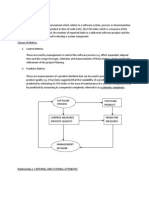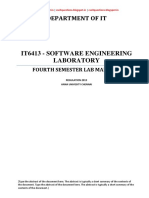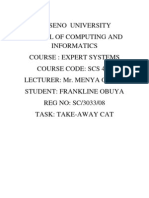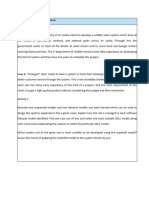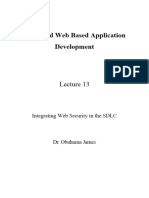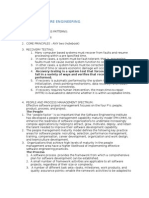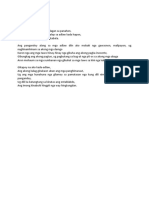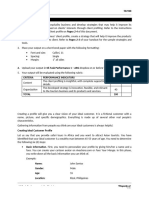0 ratings0% found this document useful (0 votes)
34 viewsREG: DIT/2013/41255 Name: Akuei Kuol Joseph Unit Code: Dit 2211 Unit Title: Software Engeeniring
REG: DIT/2013/41255 Name: Akuei Kuol Joseph Unit Code: Dit 2211 Unit Title: Software Engeeniring
Uploaded by
JamesMainaThis document contains details from a student's software engineering exam, including questions and answers on topics like project management, software development processes, quality assurance, security requirements, logical security mechanisms, and risk management. For question 1, the student identifies stakeholders and areas to include in a library book loan system project proposal. They then explain the typical project management lifecycle and provide disadvantages for waterfall and evolutionary development approaches. The student also defines concepts like correctness, reliability, and maintainability in software quality assurance, and lists attributes of a good computer interface. Finally, they outline security requirements, logical security mechanisms, and define risk management and its importance in software engineering.
Copyright:
© All Rights Reserved
Available Formats
Download as DOCX, PDF, TXT or read online from Scribd
REG: DIT/2013/41255 Name: Akuei Kuol Joseph Unit Code: Dit 2211 Unit Title: Software Engeeniring
REG: DIT/2013/41255 Name: Akuei Kuol Joseph Unit Code: Dit 2211 Unit Title: Software Engeeniring
Uploaded by
JamesMaina0 ratings0% found this document useful (0 votes)
34 views5 pagesThis document contains details from a student's software engineering exam, including questions and answers on topics like project management, software development processes, quality assurance, security requirements, logical security mechanisms, and risk management. For question 1, the student identifies stakeholders and areas to include in a library book loan system project proposal. They then explain the typical project management lifecycle and provide disadvantages for waterfall and evolutionary development approaches. The student also defines concepts like correctness, reliability, and maintainability in software quality assurance, and lists attributes of a good computer interface. Finally, they outline security requirements, logical security mechanisms, and define risk management and its importance in software engineering.
Original Description:
Software Engineeering
Original Title
Software Engineering
Copyright
© © All Rights Reserved
Available Formats
DOCX, PDF, TXT or read online from Scribd
Share this document
Did you find this document useful?
Is this content inappropriate?
This document contains details from a student's software engineering exam, including questions and answers on topics like project management, software development processes, quality assurance, security requirements, logical security mechanisms, and risk management. For question 1, the student identifies stakeholders and areas to include in a library book loan system project proposal. They then explain the typical project management lifecycle and provide disadvantages for waterfall and evolutionary development approaches. The student also defines concepts like correctness, reliability, and maintainability in software quality assurance, and lists attributes of a good computer interface. Finally, they outline security requirements, logical security mechanisms, and define risk management and its importance in software engineering.
Copyright:
© All Rights Reserved
Available Formats
Download as DOCX, PDF, TXT or read online from Scribd
Download as docx, pdf, or txt
0 ratings0% found this document useful (0 votes)
34 views5 pagesREG: DIT/2013/41255 Name: Akuei Kuol Joseph Unit Code: Dit 2211 Unit Title: Software Engeeniring
REG: DIT/2013/41255 Name: Akuei Kuol Joseph Unit Code: Dit 2211 Unit Title: Software Engeeniring
Uploaded by
JamesMainaThis document contains details from a student's software engineering exam, including questions and answers on topics like project management, software development processes, quality assurance, security requirements, logical security mechanisms, and risk management. For question 1, the student identifies stakeholders and areas to include in a library book loan system project proposal. They then explain the typical project management lifecycle and provide disadvantages for waterfall and evolutionary development approaches. The student also defines concepts like correctness, reliability, and maintainability in software quality assurance, and lists attributes of a good computer interface. Finally, they outline security requirements, logical security mechanisms, and define risk management and its importance in software engineering.
Copyright:
© All Rights Reserved
Available Formats
Download as DOCX, PDF, TXT or read online from Scribd
Download as docx, pdf, or txt
You are on page 1of 5
REG: DIT/2013/41255
NAME: AKUEI KUOL JOSEPH
UNIT CODE: DIT 2211
UNIT TITLE: SOFTWARE ENGEENIRING
CAT 2
1. The university Library is considering the implementation of a computer based system
to help administrator books loan at the library.
a) Identify at least four stakeholders in such a project.
Librarian
Library Staff
Administrator/ Technical Board
Book Suppliers/ Volunteers
Friends of the Library (Providing funds and assistance to Library)
Educators/ Trainers (train the usage of the system)
Software House or company developing the computer based system
Library Users (those who lend the books)
b) Explain any four areas that must be included in a project proposal for this project.
i. Components of the project in terms of needs to achieve the vision
ii. Specifications for system requirements
iii. Financial estimates
iv. Action plan and Timetable for the project
2. Briefly explain the activities of a typical project management life cycle
Initiationinvolves starting up the project, by documenting a business case,
feasibility study, and terms of reference, appointing the team and setting up a
Project Office.
Planning involves setting out the roadmap for the project by creating the
following plans: project plan, resource plan, financial plan, quality plan,
acceptance plan and communications plan.
Execution involves building the deliverables and controlling the project delivery,
scope, costs, quality, risks and issues.
Closureinvolves winding-down the project by releasing staff, handing over
deliverables to the customer and completing a post implementation review.
3. Give two disadvantages for each of the following software development process
models. (2marks)
a) Waterfall approach
Disadvantages
You cannot go back a step; if the design phase has gonewrong, things can get very
complicated in the implementation phase.
High amounts of risk and uncertainty.
Not a good model for complex and object-oriented projects.
Poor model for long and on-going projects.
Not suitable for the projects where requirements are at amoderate to high risk of
changing.
b) Evolutionary development
Disadvantages
Because the project is open-ended, no time frame can be set.
Project monitoring is difficult.
Less visibility as compared to waterfall model.
4. Briefly explain the following software quality assurance attributes (4 marks)
Correctness: The correctness of a software system refers to:
Agreement of program code with specifications
- Independence of the actual application of the software system.
The correctness of a program becomes especially critical when it is
embedded in a complex software system.
Reliability: Reliability of a software system derives from
- Correctness
- Availability
The behavior over time for the fulfillment of a given specification depends on the
reliability of the software system.
-Reliabilityof a software system is defined as the probability that this system fulfills a
function (determined by the specifications) for a specified number of input trials
under specified input conditions in a specified time interval (assuming that hardware
and input are free of errors).
-A software system can be seen as reliable if this test produces a low error rate (i.e.,
the probability that an error will occur in a specified time interval.)
The error rate depends on the frequency of inputs and on the probability that an
individual input will lead to an error.
Maintainability: Maintainability = suitability for debugging (localization and
correction of errors) and for modification and extension of functionality.
The maintainability of a software system depends on its:
- Readability
- Extensibility
- Testability
5. Briefly explain 5 major attributes of a good interface for a computer System (4
marks)
ClarityThe interface avoids ambiguity by making everything clear through language,
flow, hierarchy and metaphors for visual elements.
Concision- Its easy to make the interface clear by over-clarifying and labeling
everything, but this leads to interface bloat, where there is just too much stuff on the
screen at the same time. If too many things are on the screen, finding what youre
looking for is difficult, and so the interface becomes tedious to use. The real challenge
in making a great interface is to make it concise and clear at the same time.
Familiarity- Even if someone uses an interface for the first time, certain elements can
still be familiar. Real-life metaphors can be used to communicate meaning.
Responsiveness-A good interface should not feel sluggish. Secondly, the interface
should provide good feedback to the user about whats happening and whether the
users input is being successfully processed.
Consistency-Keeping your interface consistent across your application is important
because it allows users to recognize usage patterns.
6. What are the 3 requirements standards of security(2 marks)
Data confidentiality - controlling who gets to read information in order to keep sensitive
Information from being disclosed to unauthorized recipients - e.g., preventing the disclosure
ofClassified information to an adversary
Data integrity - assuring that information and programs are changed, altered, or modified
only in aSpecified and authorized manner
System availability - assuring that authorized users have continued and timely access to
information
and resources - e.g., preventing an adversary from flooding a network with bogus traffic that
delayslegitimate traffic such as that containing new orders from being transmitted
7. State and briefly explain five major logical security mechanisms one can do to
ensure information systems are secure (5 marks)
a) Digital signature - assurance that a message or file was sent or created by a given person,
based onthe capabilities provided by mechanisms for authentication and integrity checks
b) Authenticate
-To verify the identity of a person (or other agent external to the protection system)
making a request.
-verifying the identity of a prospective user by demanding a password,
c) Authorization
To grant a principal access to certain information.
d) Auditing - recording each operation that is invoked along with the identity of the subject
performingit and the object acted upon (as well as later examining these records)
e) Non-repudiation- the use of a digital signature procedure affirming both the integrity of a
givenmessage and the identity of its creator to protect against a subsequent attempt to deny
authenticity.
8. Define risk management and explain its importance in software engineering(2)
Risk management is a series of steps whose objectives are to identify,address, and
eliminate software risk items before they become either threats to successful
software operation or a major source of expensive rework.
The main objective of Risk Management is to identify potential problems
before they occur so that risk handling activities can be planned and
invoked as needed across the life of the product or project to mitigate
adverse impacts on achieving objectives.
References
1. N.R. Mead, E.D. Hough, and T.R. Stehney II, "Security Quality Requirements
(SQUARE) Methodology" (CMU/SEI-2005-TR-009), Software Engineering Institute,
Carnegie Mellon University, Pittsburgh, PA, 2005.
2. NIST Risk Management Guide for Information Systems Special Publication
800-30. July, 2002
You might also like
- A Finding Aid To The Erwin Panofsky PapersDocument63 pagesA Finding Aid To The Erwin Panofsky PapersshervinkNo ratings yet
- Lab #3 - Assessment Worksheet: A. Healthcare Provider Under HIPPA Compliance LawDocument5 pagesLab #3 - Assessment Worksheet: A. Healthcare Provider Under HIPPA Compliance LawDuong Chi Hung (K15 HCM)No ratings yet
- 1909 WFDocument71 pages1909 WFBob HazNo ratings yet
- Table of Rating FactorDocument4 pagesTable of Rating FactorNin BANo ratings yet
- QUESTIONSDocument13 pagesQUESTIONSbasesaliberatusNo ratings yet
- SEDocument8 pagesSEphoolkumari2229999No ratings yet
- Sepm Ese AnsDocument76 pagesSepm Ese AnsParth InamdarNo ratings yet
- Category: This Is About All Aspects of (SW) Which Here Is Taken To Include The Following CategoriesDocument11 pagesCategory: This Is About All Aspects of (SW) Which Here Is Taken To Include The Following CategoriesKeval PatelNo ratings yet
- Model Answer SEDocument28 pagesModel Answer SEjjkkNo ratings yet
- Software EngineeringDocument6 pagesSoftware Engineeringsia250825No ratings yet
- SSE All Ques AnsDocument19 pagesSSE All Ques AnsRadha Krishna - with youNo ratings yet
- Project Management HandoutDocument12 pagesProject Management HandoutMcgee GakaNo ratings yet
- Problem Definition: 2.1 Existing SystemDocument4 pagesProblem Definition: 2.1 Existing Systemsushil soniNo ratings yet
- Software Engineering Unit-1 notesDocument4 pagesSoftware Engineering Unit-1 notesPriya YannamNo ratings yet
- Flipkart Test PlanDocument8 pagesFlipkart Test Planjarvishaliday0% (1)
- SE UNIT-I Lesson 1Document19 pagesSE UNIT-I Lesson 1vg537701No ratings yet
- CC105 ReviewerDocument7 pagesCC105 ReviewerMark James Dela CruzNo ratings yet
- 1SPM NoteDocument126 pages1SPM Notenmadhura14No ratings yet
- Explain What Is Need of System DesignDocument9 pagesExplain What Is Need of System Designnameayush06No ratings yet
- Ignou Mca Mcs-034 Solved Assignment 2011Document7 pagesIgnou Mca Mcs-034 Solved Assignment 2011cutehacker22No ratings yet
- IT301 - Assignment in Theoretical Understanding of SDLCDocument5 pagesIT301 - Assignment in Theoretical Understanding of SDLCroniversonrocas33No ratings yet
- Software Engineering Lab ManualDocument70 pagesSoftware Engineering Lab ManualPRIYA RAJI96% (25)
- Software Engineering Imp'sDocument17 pagesSoftware Engineering Imp'slabdhigandhi2003No ratings yet
- AI Note For AllDocument14 pagesAI Note For AllRahatul RifatNo ratings yet
- Software Engineering Cat OneDocument4 pagesSoftware Engineering Cat OneISAACNo ratings yet
- Answer Key - Sem-In-1 - Regular SE MID-1Document8 pagesAnswer Key - Sem-In-1 - Regular SE MID-1Chinnu JashuvaNo ratings yet
- MCS-034 - Software Engineering Solved Assignments 2011Document6 pagesMCS-034 - Software Engineering Solved Assignments 2011Anita Khanna100% (1)
- SYAD Prefinal Exams FINALDocument5 pagesSYAD Prefinal Exams FINALBien Joshua Martinez PamintuanNo ratings yet
- S.E Text Book.Document38 pagesS.E Text Book.jy yusufiNo ratings yet
- Dbms Project by Shivam SinghDocument9 pagesDbms Project by Shivam SinghwhoshivammNo ratings yet
- Railway e TicketingDocument16 pagesRailway e TicketingKashishAhuja0% (1)
- Expert SystemDocument7 pagesExpert SystemGeorge Johnson ClayNo ratings yet
- SE 5markDocument5 pagesSE 5markarunkumaran132004No ratings yet
- Top 10 Architecture CharacteristicsDocument11 pagesTop 10 Architecture CharacteristicsAnoopkumar AKNo ratings yet
- 404-Software Engineering-Solution-HarshitDocument13 pages404-Software Engineering-Solution-Harshitdifalek823No ratings yet
- Software EngineeringDocument175 pagesSoftware Engineeringbiswadeepbasak0212No ratings yet
- Setting A Marking Guide: SWE413 Software Development: Section A: Short Answer Questions (3 Marks Each, Total 15 Marks)Document4 pagesSetting A Marking Guide: SWE413 Software Development: Section A: Short Answer Questions (3 Marks Each, Total 15 Marks)Azinwi BorisNo ratings yet
- 20cs4103 Se Unit 1Document33 pages20cs4103 Se Unit 1karthikap.cseNo ratings yet
- 1unit SeDocument27 pages1unit SeShilpa PutanikarNo ratings yet
- SEN Notes - Unit 1Document28 pagesSEN Notes - Unit 1Om DevharkarNo ratings yet
- Software Development ProcessDocument2 pagesSoftware Development ProcessNilesh SinghNo ratings yet
- 2K20 CO 015 Abhay SharmaDocument10 pages2K20 CO 015 Abhay Sharma2K20CO355 Ranjeet MadhavNo ratings yet
- Rutuja Deelp Fulbagkar and Aakanksha Barbare: Developed byDocument57 pagesRutuja Deelp Fulbagkar and Aakanksha Barbare: Developed byvKPNo ratings yet
- SQA Assignment 2Document2 pagesSQA Assignment 2Rohit MauryaNo ratings yet
- Test Tu Cuoi KyDocument4 pagesTest Tu Cuoi KyHoàng VươngNo ratings yet
- Assignment Brief and GuidanceDocument9 pagesAssignment Brief and Guidancerifashamid25No ratings yet
- Unit 5 SE CompleteDocument16 pagesUnit 5 SE CompleteSiddharth singh RaghuwanshiNo ratings yet
- CHAPTER 1 Software Engg.Document11 pagesCHAPTER 1 Software Engg.Ayush KaushikNo ratings yet
- Lecture 13 NotesDocument8 pagesLecture 13 Noteswannabedaniel77No ratings yet
- CHAPTER - THREE - SYSTEM - ANALYSIS - AND - DESIGN (AutoRecovered)Document14 pagesCHAPTER - THREE - SYSTEM - ANALYSIS - AND - DESIGN (AutoRecovered)Yakubu AliuNo ratings yet
- SDL Assignment 2Document13 pagesSDL Assignment 2Farooq ChaudharyNo ratings yet
- Software Engineering NotesDocument61 pagesSoftware Engineering NotesAnonymous L7XrxpeI1z100% (3)
- 80 Marks Software Engineering: Fail in A Variety of Ways and Verifies That Recovery Is Properly PerformedDocument9 pages80 Marks Software Engineering: Fail in A Variety of Ways and Verifies That Recovery Is Properly Performedsaurabmi2No ratings yet
- What Is Software Architecture?: Describe Softwarearchitecture in Your Own Words. (5) Software ArchitectureDocument6 pagesWhat Is Software Architecture?: Describe Softwarearchitecture in Your Own Words. (5) Software ArchitectureShruthi JalalpuramNo ratings yet
- Chapter 01Document7 pagesChapter 01Rifat ahmmedNo ratings yet
- Medi Connect Spiral Model Case StudyDocument5 pagesMedi Connect Spiral Model Case Studybalasahebnalawade843No ratings yet
- Software EngineeringDocument10 pagesSoftware Engineering777kenadam777No ratings yet
- S.E Exam NotessssDocument23 pagesS.E Exam NotessssDeepak bajirao shindeNo ratings yet
- Bus ReservationDocument65 pagesBus ReservationMohd HaiderNo ratings yet
- Security Challenges of DS?: 2.what Do You Mean by Scalability of A System?Document10 pagesSecurity Challenges of DS?: 2.what Do You Mean by Scalability of A System?SirishaNo ratings yet
- Question 1Document3 pagesQuestion 1vlora.william15No ratings yet
- Unit 4 SDLCDocument5 pagesUnit 4 SDLChsisjsboNo ratings yet
- Software Testing Interview Questions You'll Most Likely Be AskedFrom EverandSoftware Testing Interview Questions You'll Most Likely Be AskedNo ratings yet
- Zandra Pia Lariosa - Balak and Poems ManuscriptDocument4 pagesZandra Pia Lariosa - Balak and Poems ManuscriptZANDRA PIA LARIOSANo ratings yet
- Watertite TE 40Document2 pagesWatertite TE 40Alexi ALfred H. TagoNo ratings yet
- PFDA Registration RequirementsDocument4 pagesPFDA Registration RequirementsRosenda Monette100% (1)
- Lamella EcoflowDocument3 pagesLamella EcoflowLeonardo SilvaNo ratings yet
- 06 Performance Task 1 - ARGDocument3 pages06 Performance Task 1 - ARGRuby Joy G. BugtongNo ratings yet
- Community Problem ReportDocument9 pagesCommunity Problem Reportapi-385897772No ratings yet
- SITEC-PM180-Datasheet 16Document1 pageSITEC-PM180-Datasheet 16Thriloknath PallaNo ratings yet
- Broms MethodDocument8 pagesBroms MethodJajat Sudrajat0% (1)
- F 16323Document132 pagesF 16323Nwogu EnyinnaNo ratings yet
- Foam FormationDocument3 pagesFoam Formationrahulsaini855No ratings yet
- HCI434FS/444FS - Technical Data SheetDocument8 pagesHCI434FS/444FS - Technical Data SheetHERS14No ratings yet
- Lecture 2 Classifications, Termonolgy and Components PDFDocument79 pagesLecture 2 Classifications, Termonolgy and Components PDFMemo KhalidNo ratings yet
- 2016-2019 Paper 2 Revision PDFDocument140 pages2016-2019 Paper 2 Revision PDFslap bwoy100% (1)
- Sangeetahealingtemples Com Tarot Card Reading Course in UsaDocument3 pagesSangeetahealingtemples Com Tarot Card Reading Course in UsaSangeetahealing templesNo ratings yet
- Litrature Review On Topography of ChiplunDocument6 pagesLitrature Review On Topography of ChiplunMoin KhotNo ratings yet
- English 12thDocument8 pagesEnglish 12thsonalimandal123sdNo ratings yet
- Assignment 2 2021Document2 pagesAssignment 2 2021Perpetual hubbyNo ratings yet
- Eng4 - Sule, Romero e - Lesson PlanDocument10 pagesEng4 - Sule, Romero e - Lesson PlanRomero SuleNo ratings yet
- Grand Shift To Post COVID-19 WorldDocument112 pagesGrand Shift To Post COVID-19 WorldEntio BaezNo ratings yet
- Lecture-6 Causatve VerbDocument4 pagesLecture-6 Causatve VerbMahfuzur RahmanNo ratings yet
- Api I C2Document31 pagesApi I C2mihai37No ratings yet
- End User Procedure (EUP) General Analyses ME80FN: PurposeDocument10 pagesEnd User Procedure (EUP) General Analyses ME80FN: PurposeAdauto PolizeliNo ratings yet
- Kossodo Hotplate CeramicoDocument2 pagesKossodo Hotplate CeramicoCarlos Gene QuirozNo ratings yet
- Operation Principal of Screw CompressorDocument1 pageOperation Principal of Screw Compressornarayan46100% (1)
- Pressure Seal Valves-GateDocument24 pagesPressure Seal Valves-GateHieu NguyenNo ratings yet
- Defect Prevention TechniquesDocument229 pagesDefect Prevention TechniquesZarko AcimovicNo ratings yet
- Gestalt Psychology or GestaltismDocument11 pagesGestalt Psychology or GestaltismBroy D BriumNo ratings yet











